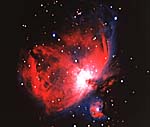Do new stars form today?

The complete birth of a star has never been observed. The principles of physics demand some special conditions for star formation and also a long time period. A cloud of hydrogen gas must be compressed to a sufficiently small size so that gravity dominates. (As an example, the sun is a stable sphere of gas.) In space, however, almost every gas cloud is light-year in size, hundreds of times greater than the critical size needed for a stable star. As a result, outward gas pressures cause these clouds to spread out farther, not contract.
A number of mechanisms have been proposed to trigger the beginning of star formation. Most popular is a pressure or density wave in space, which might squeeze dust clouds down to star-forming size. This pressure wave is suggested to originate from a nearby supernova or exploding star. The net result is that stars are said to form from other stars. But where do the first stars come from in this circular reasoning? Another problem for this theory of stellar origins is the great distance between stars. Most are isolated from each other by ten light-years or more and thus would appear unable to influence each other's origin in any significant way.
Scientists point to certain areas where they believe stars may be forming today. One of these rare spots is the Orion Nebula, a glowing gas cloud in the December sky. The infrared radiation emitted from this cloud is thought to be perhaps related to the start-up energy from new stars. However, there is too much gas and dust to see these stars, and the source of this infrared radiation may actually be some type of star that has existed in the gas cloud for a long time. All assumptions regarding present-day star formation remain speculative.
The creationist also sees a time-scale problem with theories about present-day star formation. Although computer models typically give a million-year start-up time for new stars, such unlimited time is not available in a “young” universe. Observations of space reveal the universal trend of star degeneration, not star formation. Star formation may occur today in certain locations where conditions are met. However, it is doubtful that such rare star births can replace the many dying stars. Star decay is a fairly common event in the form of novas and supernovas. We can conclude that the universe of created stars is slowly aging.
Author: Dr. Donald B. DeYoung - adapted from Astronomy and the Bible: Questions and Answers, 2nd Edition (Grand Rapids, Michigan: Baker Books, 2000), 176 pp.
Copyright © 2000, Films for Christ, All Rights Reserved—except as noted on attached “Usage and Copyright” page that grants ChristianAnswers.Net users generous rights for putting this page to work in their homes, personal witnessing, churches and schools.